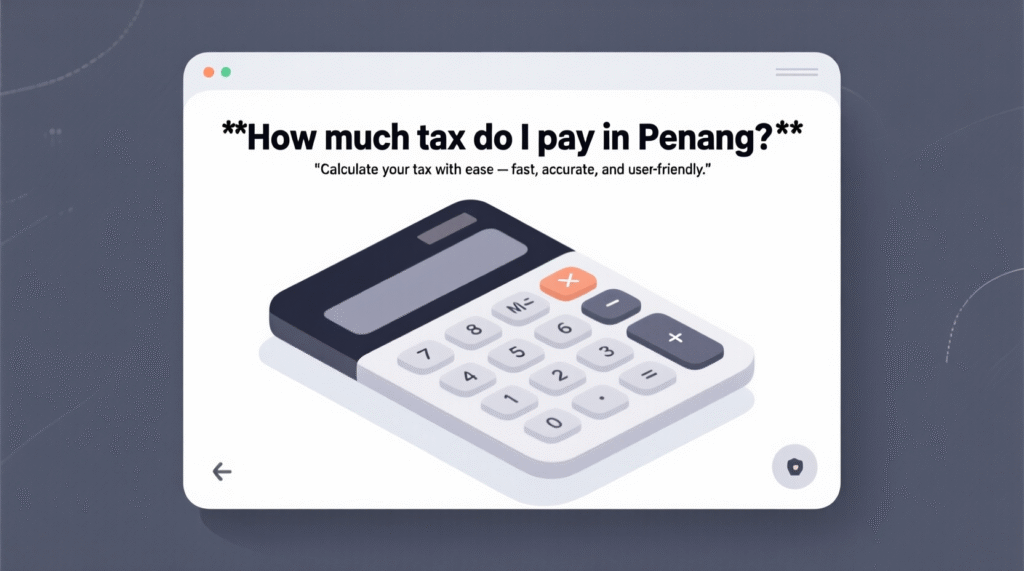
Navigating taxes in Penang is straightforward because it follows the national tax system of Malaysia, managed by the Inland Revenue Board of Malaysia (LHDN). The amount of tax you pay depends on whether you’re an individual or a business, as well as your residency status.
How Do I Calculate Individual Income Tax?
Your individual income tax in Penang is based on a progressive scale. This means the more you earn, the higher your tax rate. The rates for the Year of Assessment 2025 are what you need to focus on.
To calculate your tax, you first need to determine your chargeable income.
Chargeable Income = Total Income – Tax Reliefs – Deductions
Once you have your chargeable income, you apply the progressive tax rates.
| Chargeable Income (RM) | Tax Rate | Cumulative Tax |
| First 5,000 | 0% | RM 0 |
| Next 15,000 (5,001 – 20,000) | 1% | RM 150 |
| Next 15,000 (20,001 – 35,000) | 3% | RM 600 |
| Next 15,000 (35,001 – 50,000) | 6% | RM 1,500 |
| Next 20,000 (50,001 – 70,000) | 11% | RM 3,700 |
| Next 30,000 (70,001 – 100,000) | 19% | RM 9,400 |
| Next 300,000 (100,001 – 400,000) | 25% | RM 84,400 |
| Next 200,000 (400,001 – 600,000) | 26% | RM 136,400 |
| Next 1,400,000 (600,001 – 2,000,000) | 28% | RM 528,400 |
| Exceeding 2,000,000 | 30% | – |
Example Calculation
Let’s say your chargeable income is RM 65,000.
- First RM 50,000 is taxed at RM 1,500.
- The remaining RM 15,000 (RM 65,000 – RM 50,000) is taxed at 11%, which is RM 1,650.
- Total tax payable: RM 1,500 + RM 1,650 = RM 3,150.
Key Tax Reliefs and Deductions
Tax reliefs are crucial for reducing your tax bill. Always remember to collect receipts to substantiate your claims.
- Self and Dependent Relatives: RM 9,000
- Life Insurance & EPF: Up to RM 7,000 (combined)
- Lifestyle: Up to RM 2,500 for items like books, personal computers, and sports equipment.
- Medical Expenses for Parents: Up to RM 8,000.
- Education and Medical Insurance: Up to RM 3,000.
What About Corporate Tax in Penang?
For businesses, the corporate tax rate depends on the company’s size.
- Standard Rate: The flat corporate tax rate is 24% for most companies.
- SME Rates: Small and Medium-sized Enterprises (SMEs) with a paid-up capital of RM 2.5 million or less and gross income not exceeding RM 50 million get a tiered rate:
- 15% on the first RM 150,000 of chargeable income.
- 17% on the next RM 450,000.
- 24% on the remaining balance.
Other Important Taxes to Consider
While income tax is primary, you might encounter other taxes in Penang:
- Sales & Service Tax (SST): This is a consumption tax. A sales tax of 5% or 10% is applied to goods, while a service tax of 6% or 8% is charged on services. Food & beverages, telecommunications, and logistics services remain at 6%.
- Real Property Gains Tax (RPGT): This is a tax on the profit from selling real estate. The rate varies based on how long you have owned the property and whether you are a Malaysian citizen, permanent resident, or foreigner.
- Stamp Duty: This is a tax on legal documents, like those for property transfers and loan agreements.
Frequently Asked Questions (FAQs)
- How do I file my taxes in Penang? You file your taxes online through the official LHDN website’s MyTax portal. It’s an easy-to-use system that allows you to submit your e-B form (for employed individuals) or e-BE form (for businesses).
- What is the tax residency rule in Malaysia? You are considered a tax resident if you are physically present in Malaysia for at least 182 days in a calendar year. This status is key to claiming tax reliefs.
- Can foreigners living in Penang get tax reliefs? Yes, if a foreigner meets the 182-day residency rule, they are treated as a tax resident and can claim the same reliefs as a Malaysian citizen.
- What happens if I don’t file my taxes on time? LHDN imposes penalties for late filing and payment, which can include fines and additional charges on the outstanding tax amount. It’s crucial to meet the annual deadline to avoid penalties.
- What are some common mistakes to avoid when filing taxes? The most common mistakes are failing to claim all eligible reliefs, not keeping proper documentation (like receipts), and using an incorrect tax reference number.
Willium is the creator of IncomeTaxCalculatorMalaysia.com, a trusted resource for accurate and easy-to-use tax calculation tools. With a deep understanding of Malaysia’s tax system, he helps individuals and businesses estimate their income tax with confidence. Willium is dedicated to simplifying financial decisions by offering clear, reliable tools and expert guidance, empowering users to stay informed and save time.
